One of my friends was telling me about what was probably his favorite Redentor, and it had nothing to do with the fireworks.
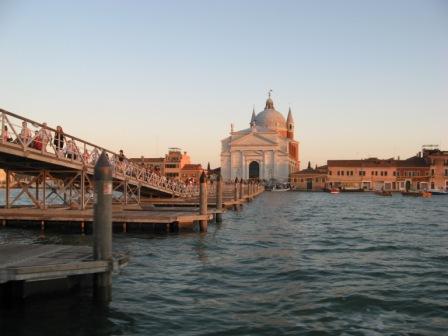
“Redentor” means “redeemer” in Venetian. (“Redentore” in Italian.) But what it really means is one of the great all-time festivals still walking the earth, and while the sacred day is always the third Sunday in July, the mega-party is the night before.
The third Saturday in July, therefore, is what history has come to know as “la note famosissima,” the most famous night, and this celebration has been made every year since 1577. Boats! Food! Fireworks! But behind all the festivity is a black and horrific story.
On June 25, 1575, someone in the parish of S. Marziale died of plague. Not uncommon in Venice, it being a major seaport, and some epidemics had already been terrible. In this case, the infected rat, so to speak, was later identified as having been a man from Trento who was visiting a certain Vincenzo Franceschini. In a little less than two years, 51,000 people (some accounts say 70,000) had died, more than one-third of the entire population. It was a hecatomb.
In that era pestilence was regarded as a form of divine punishment, so on September 21, 1576 — after having spent a year watching their city begin to disappear before their eyes — the Venetian Senate approved the proposal of doge Alvise I Mocenigo to make a solemn vow: If the Lord God Almighty would remove this scourge from them, they would build a church ” which their descendants would solemnly visit…in perpetual memory of the blessing received.”
When you study this phrase, you grasp that they weren’t merely promising a church, which the Lord presumably already had plenty of, though another one is always nice, but eternal gratitude expressed in a tangible way forever. That’s different.
The church — more correctly termed a votive temple — would be dedicated to the Most Holy Redeemer, and would be built on the Giudecca. The commission was given to Andrea di Pietro della Gondola, otherwise known as Palladio, who was the chief architect in the service of the Republic, and the seriousness of their intention was shown by laying the first stone on May 3, 1577, when the plague was still raging. They had made a vow and they were going to stick to it.
Only a few months later, on the third Sunday of July, doge Sebastiano Venier declared the city free of plague. A temporary wooden church was hastily constructed for the celebrations, and a bridge was laid across a line of boats stretching across the Giudecca Canal — like the one today, it was roughly 1,082 feet long. This bridge enabled the doge and the Senate to arrive in solemn procession at the church for the big ceremony.
And so it has gone, every year since 1577, and every doge and mayor has been there with the exception of doge Leonardo Dona’ in 1612. He snubbed the ritual because the city was mad at him and I gather he shared the sentiment, but staying away didn’t help him much because then people started going around saying, “The day’s going to come when he’d like to go to church, and he won’t be able to.” It makes an annoying little rhyme in Italian. He was an amazing doge, actually; I’m sorry they couldn’t all get along.
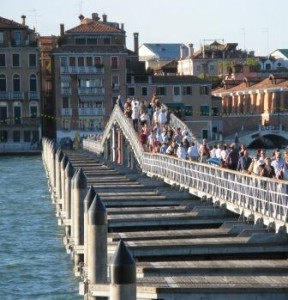
I myself wouldn’t consider it Redentor without walking across the bridge at least once. They’re working to get it finished even as I write. Not many days left. Seeing the bridge slowly take form (after boats, they switched to pontoons, and a few years ago a new system was adopted by which the sections are impaled on pilings) adds a great deal to the sense of anticipation.
The bridge is officially opened with a modest ceremony at 7:00 PM on Saturday, and closed at 10:00 PM on Sunday. The life-span of a fruit fly, essentially, which makes it all the better.
Back to that favorite episode of this epic-yet-homely tradition. It took place somewhere back in time, because he went to Nino at Campo San Boldo to rent a boat. There are no more affittabatelli (boat-renters) in Venice, but when he was a lad, and even up till the Sixties, the city was full of places where you could rent a Venetian boat — sandolo, mascareta, caorlina, even a peata — for whatever task was at hand, something like the Zipcar of its time.
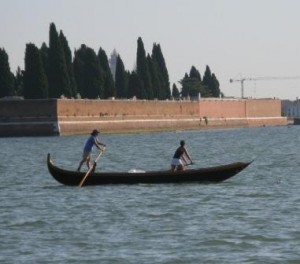
Then he and his friends constructed the customary framework to support a kind of temporary roof made of assorted branches. And they strung the usual paper lanterns along it. The lanterns swing and bob with the motion of the boat in a very cheerful way.
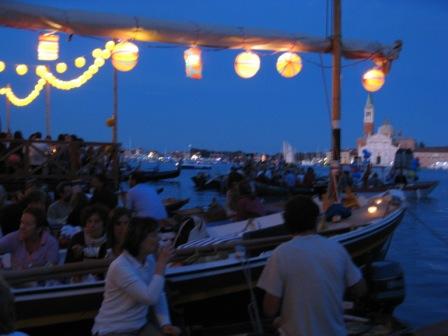
Then they set up a table in the middle of the boat, the ladies brought the food, and of course wine, and they were good to go.
The evening took its usual course, which it will also take this year: You row (or motor) in your boat to whatever spot looks good to you, as long as it generally corresponds to the official map which divides areas according to the size of the boat. The Venetian boats (those which are rowed, I mean) have been awarded a spot near the Punta della Dogana, where we all cluster together in our own little world.
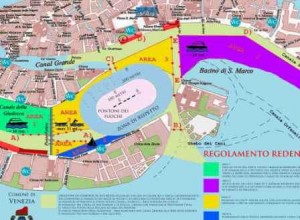
As you see, an open space of about 650 feet is maintained around the fireworks-laden barges. You throw the anchor, or tie up to another boat. The aquatic pilgrimage begins in the early afternoon, as big fishing boats from down-lagoon places like Pellestrina and Chioggia chug in, loaded like third-world ferries with hordes of people who have clearly made the most of their time in transit getting started on the party.
We go out around 6:00, row across the lagoon from the Lido. and about 7:00 we get to the Punta della Dogana (Customs-House Point, the tip of Dorsoduro where the Grand and Giudecca Canals meet). We tie up and pull out the vittles.
You eat, you drink — some people swim, because it’s usually pretty hot — eat, drink, and repeat as necessary. 
At 11:30 PM, when you’ve been out long enough for an evening chill to begin to suggest itself and sleep is washing up against you like the water around the boat, the fireworks start. Some years they’re great, some years they’re actually kind of boring; last year they were astonishingly gorgeous, brilliant, dazzling; they were so thrilling that they actually brought tears to my eyes.
Good or otherwise, they explode overhead for a solid half-hour. That may not sound like much, but it’s the visual equivalent of an opera by Wagner. It just goes on and on. 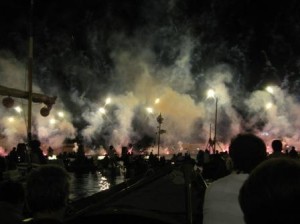
So the shrimp-tail boat was ready and so was everybody else. “Me and the family, and some friends — there were 13 of us, including the parish priest and his brother.”
“After the fireworks, we rowed to the Lido and went swimming.” (Technically, this also is part of the tradition, but not many people still do it anymore.) Of course it was great, except that “You never get dry after you swim in the sea at night.”
“Then along toward dawn we began to head home. I remember it as if it were now — the guys would alternate to row in the prow, I was rowing astern, and by now we all groggy” (he closes his eyes almost all the way and mimics languid, somnolent rowing, as if each stroke is the last one before you stop completely).
“All the women and kids and everybody was sprawled all over the table, their heads on their arms, sleeping, or dozing, anyway. A few were sort of singing a little bit under their breath. The tide was coming in, and as the sun came up we just sort of drifted back to the city.”
By now I’ve heard this story fairly often, usually in July. It’s one of a number of his reminiscences that I love to hear just as much as I did the first time around. It’s not only because it’s such a beautiful scene and I wish I’d been there, but because every time he tells it, he looks really happy.
He occasionally also refers to the way Redentore was in general, when he was a boy. And this account does not make him look happy, because like so many things here, what once was almost completely Venetian has mainly become just another thing to lure the tourists.
First of all, when he was a boy the fireworks weren’t over the Bacino of San Marco, but upstream, over the Giudecca Canal, near San Basilio. Up in the nabe, where people lived, as it were. And it seemed like everybody came out in their boat (as per today) but “everybody” meant 3/4 of Venice, which meant 3/4 of the people you knew. Now most of the boats are big motorized vehicles with people from somewhere else, back in the hinterland.
“You could walk across the Giudecca Canal on the boats,” he told me. When the fireworks were shifted downstream, that was the first sign that Something had Changed. And change, here, is usually away from something that’s fine the way it is and toward, well, Something Else.
As for the songs and the food that are both optional and required for this event, I’ll tell you about those next week, when I recover.

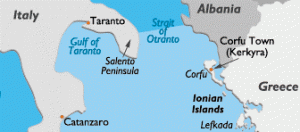 Our week in
Our week in 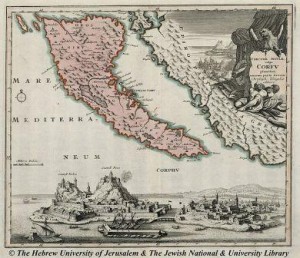
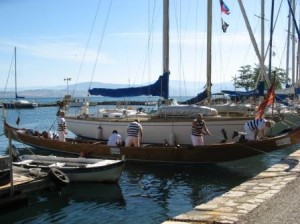
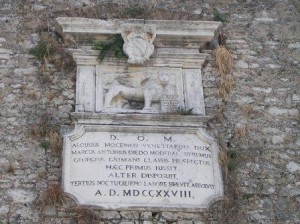
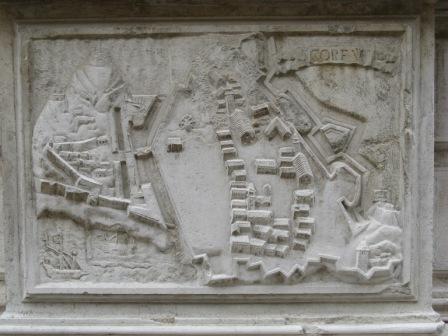
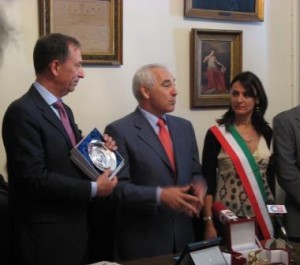


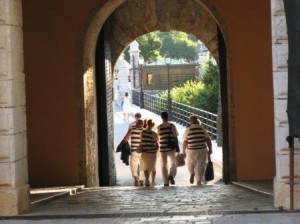
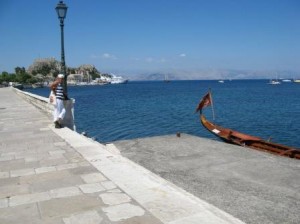
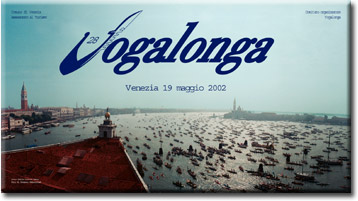
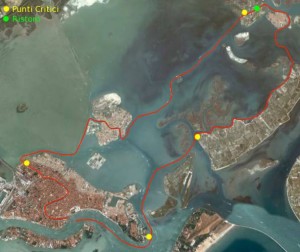
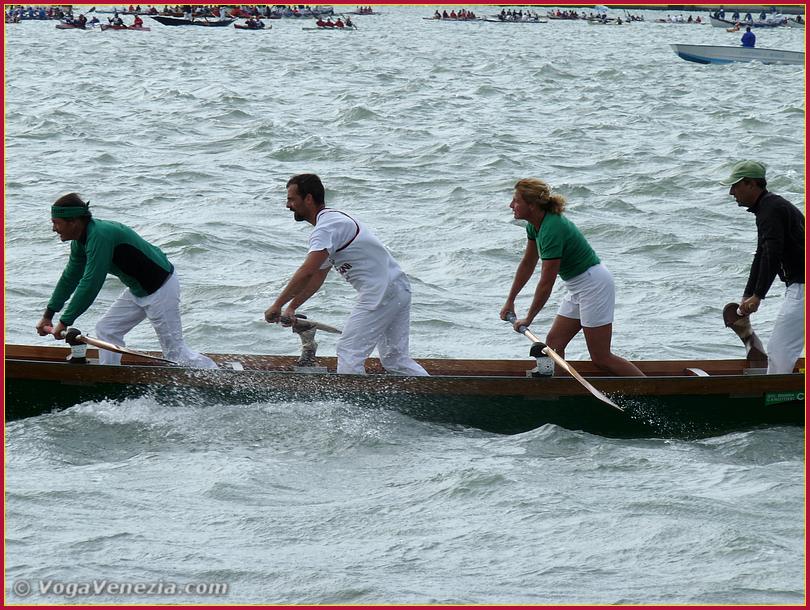
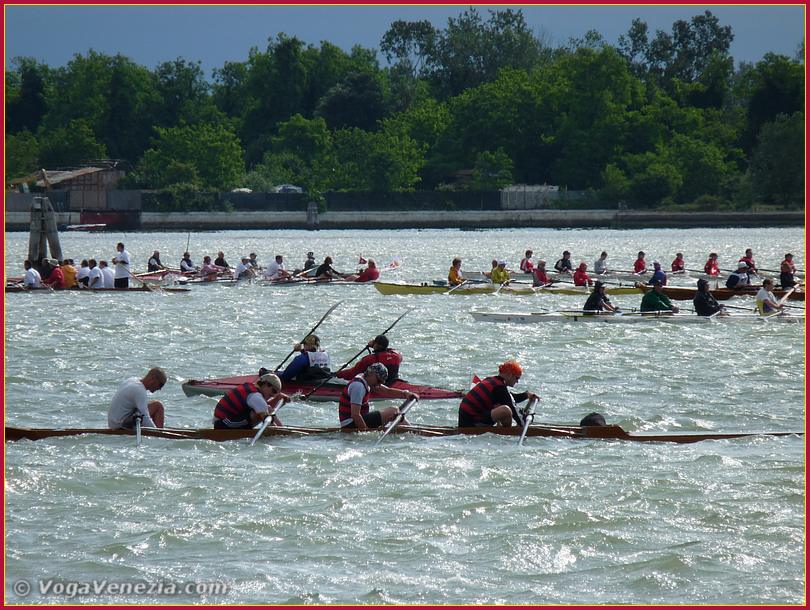
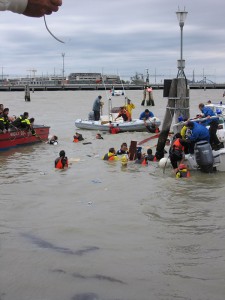
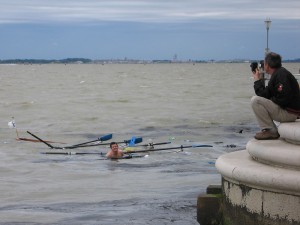

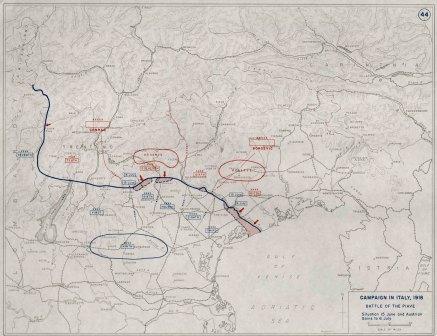 It is a pleasant little stream which starts in the Alps and empties into the sea not far from Venice, but more importantly, it formed the front which finally stopped the enemy advance and led to its ultimate defeat. The Piave is therefore also known as “The river sacred to the motherland.”
It is a pleasant little stream which starts in the Alps and empties into the sea not far from Venice, but more importantly, it formed the front which finally stopped the enemy advance and led to its ultimate defeat. The Piave is therefore also known as “The river sacred to the motherland.” 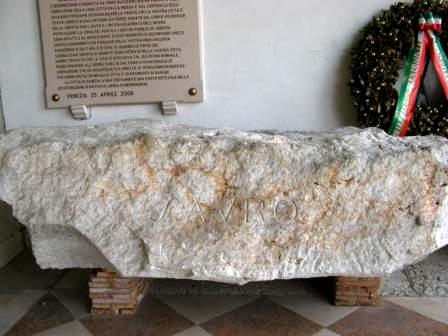 These are famous martyrs of the Italian resistance. Despite living in Austrian territory they considered themselves Italians were fighting for Italy, while according to the Austrian viewpoint they were supposed to be fighting against it. These men were epic heroes. I can’t understand why their life stories haven’t been turned into tragic operas. Where is Verdi when you need him?
These are famous martyrs of the Italian resistance. Despite living in Austrian territory they considered themselves Italians were fighting for Italy, while according to the Austrian viewpoint they were supposed to be fighting against it. These men were epic heroes. I can’t understand why their life stories haven’t been turned into tragic operas. Where is Verdi when you need him? 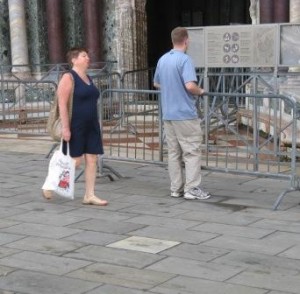
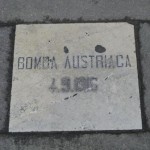
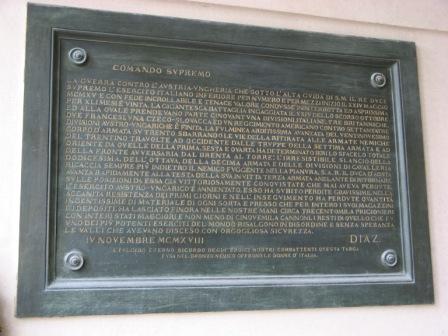 It gives the full text of the address given by General, later Marshal, Armando Diaz, chief of general staff, announcing the Italian victory of the Battle of Vittorio Veneto and the end of the war. It manages in very few lines not only to report the precise details of the enemy’s undoing but to convey every emotion conceivable in the victors of a struggle beyond human comprehension.
It gives the full text of the address given by General, later Marshal, Armando Diaz, chief of general staff, announcing the Italian victory of the Battle of Vittorio Veneto and the end of the war. It manages in very few lines not only to report the precise details of the enemy’s undoing but to convey every emotion conceivable in the victors of a struggle beyond human comprehension.